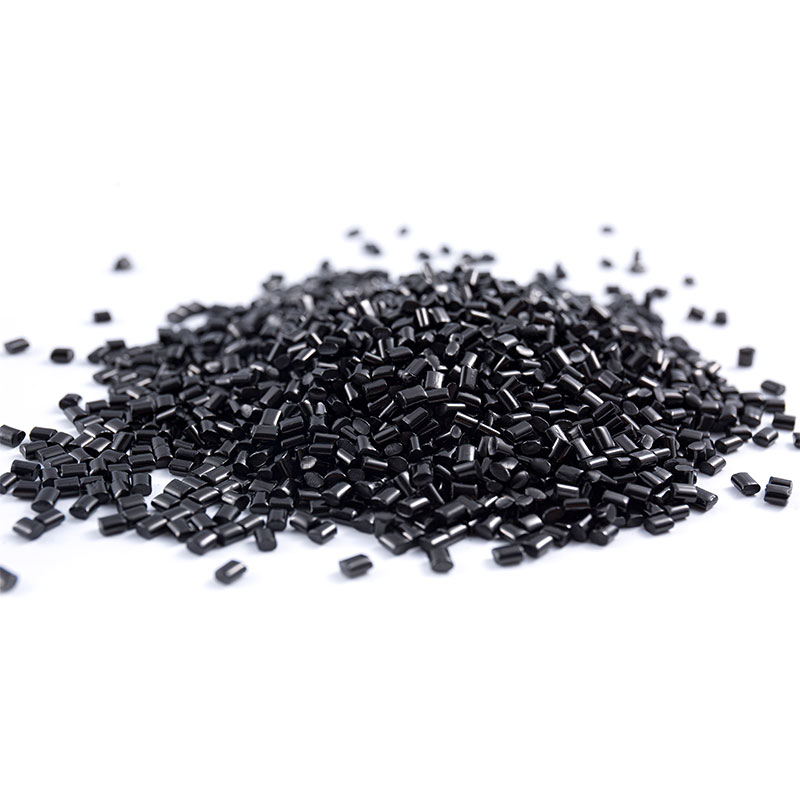Principle and Composition of PET Carrier Black Masterbatch
PET Carrier Black Masterbatch is a high-concentration masterbatch made by melt-blending PET as the carrier resin with high-blackness carbon black and various additives at high temperatures. Its basic function is to impart a uniform, stable, and deep black appearance to PET products, while simultaneously improving light-blocking properties, UV resistance, and processing stability. Because PET materials are widely used in fibers, packaging, films, and engineering plastics, the requirements for the thermal stability and dispersion performance of the masterbatch are extremely high. Therefore, PET carrier-type black masterbatch has strong technological barriers.
From a compositional perspective, PET carrier black masterbatch mainly consists of three parts: carrier resin, carbon black pigment, and functional additives. The carrier resin is usually made from high-purity PET chips or recycled PET, requiring its melting point to match the final processed material and its viscosity to be stable, ensuring that no degradation or bubbles occur during the blending process. Carbon black, as the core coloring component, directly determines its blackness, hiding power, and dispersion effect through its particle size, structure, and surface chemical properties. Commonly used carbon black grades include N220, N330, and N660. N220 possesses extremely high blackness and gloss, but it is more difficult to disperse; therefore, it is often used in combination with dispersants in high-end PET black masterbatches.
The additive system determines the processing performance and long-term stability of the masterbatch. Dispersants (such as esters, waxes, or functionalized polyesters) can significantly improve the uniformity of carbon black dispersion in the PET matrix and prevent agglomeration. Antioxidants and heat stabilizers are used to inhibit the oxidative degradation of PET in the high-temperature molten state, avoiding yellowing and molecular chain breakage. Lubricants can reduce screw torque and melt adhesion, improving production line efficiency. Some high-end masterbatches also include UV stabilizers or light stabilizers to cope with the effects of sunlight radiation in outdoor applications.
Manufacturing Process and Performance Control
The manufacturing process of PET carrier black masterbatch places extremely high demands on equipment and process control. Carbon black is a particulate material with a high specific surface area and high oil absorption capacity. Insufficient dispersion will lead to color differences, bright spots, and decreased mechanical properties in the finished product. A typical production process includes four main stages: raw material pretreatment, high-shear mixing, cooling pelletizing, and screening and packaging.
In the raw material pretreatment stage, PET material is highly hygroscopic. At high temperatures, a moisture content exceeding 0.05% will undergo hydrolysis, leading to molecular chain breakage and decreased viscosity. Therefore, PET and carbon black must be dried with hot air at 120–160°C for 4–6 hours before mixing to ensure thorough dehydration. In the high-shear mixing stage, a twin-screw extruder is used for high-temperature (approximately 280°C) melt mixing. During this process, carbon black and PET undergo intense shear force and distribution mixing to achieve nanoscale dispersion. Precise control of screw speed, temperature range, and feed rate is crucial to prevent carbon black agglomeration or PET thermal degradation.
Cooling and pelletizing are crucial steps in ensuring consistent appearance and flow properties of masterbatch. Cooling methods include water cooling and air cooling. Water-cooled pelletizing systems are suitable for mass production, but backflow of moisture must be avoided to prevent affecting drying. Air-cooled systems are suitable for fine masterbatches requiring high purity and low moisture content. After pelletizing, the masterbatch must be sieved to remove dust and excessively large particles to ensure stable feed supply in downstream applications.
Regarding performance control, the carbon black content is generally between 25% and 40%, confirmed by thermogravimetric analysis (TGA) or ash content testing. Dispersibility is observed under a microscope to determine the distribution of carbon black particles, requiring a level not exceeding 3 (ISO 18553 standard). The color difference value ΔE must be less than 1.0 to ensure color consistency between different batches. Furthermore, the melt flow index (MFR) of PET masterbatch is controlled between 10–25 g/10min, which helps balance processing flowability and product strength.
Application Areas and Industry Development Trends
PET carrier black masterbatch plays a crucial role as a fundamental material in modern industry, with applications spanning almost every level from fibers and packaging to engineering plastics. It is not only a colorant but also a performance-regulating carrier. Through precise control of carbon black dispersion, carrier compatibility, and addition ratio, materials achieve excellent appearance, opacity, and thermal stability. Especially in the PET industry, this type of masterbatch is widely used in black fibers, preforms, films, and electronic device housings, meeting complex processing conditions such as high temperature, high shear, and high gloss. With the development of high-end manufacturing, customer requirements for color masterbatches are upgrading from "coloring" to "functionality and sustainability."
Against the backdrop of industry transformation and upgrading, specialized companies like E-LUCK are becoming important forces driving technological innovation.
E-LUCK is a professional manufacturer and solutions provider specializing in the research and development and production of industrial black masterbatches. Unlike most companies that treat black masterbatch as a secondary product line, E-LUCK treats it as its sole core business, focusing on innovation across the entire process from formulation design and process optimization to performance control. This focused strategic positioning gives it a significant competitive advantage in product depth and quality stability.
E-LUCK's technological philosophy is "We do not simply supply a product; we engineer color with performance," meaning achieving synergy between color and performance through engineering design. The company possesses strong formulation development capabilities and a mature manufacturing system, providing general-purpose and high-performance black masterbatch solutions for various polymer systems. Simultaneously, E-LUCK can customize masterbatch formulations with special functions according to customer needs, such as UV Resistance, High Gloss, Low Volatile Organic Compounds, Anti-static, and Food-contact Safety, to meet performance requirements and regulatory standards across multiple fields.
E-LUCK not only provides products but also offers systematic technical support services. The company provides customers with dispersion optimization, processing compatibility guidance, and batch stability control solutions to ensure consistent performance of masterbatch under different processing equipment and environments. Through rigorous quality control and continuous process improvement, E-LUCK's black masterbatch products effectively support high-speed spinning, injection molding, and blow molding production lines, achieving high-efficiency, low-scrap industrial production.
Looking at industry trends, the future competitive focus for PET carrier black masterbatches will increasingly concentrate on high performance, green technology, and customer customization. With its focused strategy, professional technical team, and deep manufacturing expertise, E-LUCK is adapting to this trend, leading the shift from traditional coloring materials to functional composites and environmentally sustainable solutions. As global demand for recyclable PET, low-VOC materials, and functional masterbatches continues to grow, companies like E-LUCK, which focus on "defining color with performance," will become a key force driving high-quality development in the industry.

 English
English Español
Español










